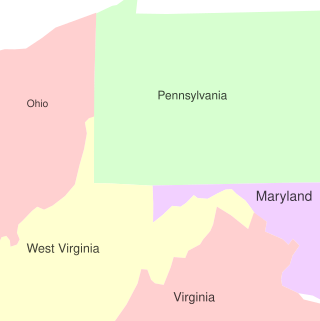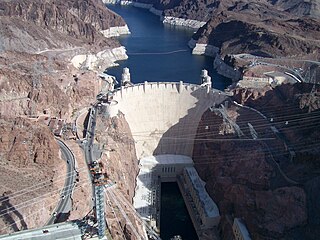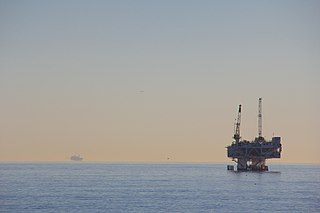
The Lower Colorado River Authority (LCRA) is a nonprofit public utility created in November 1934 by the Texas Legislature. LCRA's mission is to enhance the lives of the Texans it serves through water stewardship, energy and community service. LCRA provides public power, manages the lower Colorado River, builds and operates transmission lines, owns public parks, and offers community services.
The New York Power Authority (NYPA), officially the Power Authority of the State of New York, is a New York State public-benefit corporation. It is the largest state public power utility in the United States providing some of the lowest-cost electricity in the nation, operating 16 generating facilities and more than 1,400 circuit-miles of transmission lines. Its main administrative offices are in White Plains, New York

The electricity sector in Canada has played a significant role in the economic and political life of the country since the late 19th century. The sector is organized along provincial and territorial lines. In a majority of provinces, large government-owned integrated public utilities play a leading role in the generation, transmission, and distribution of electricity. Ontario and Alberta have created electricity markets in the last decade to increase investment and competition in this sector of the economy.

Constellation Energy Corporation is an American energy company headquartered in Baltimore, Maryland. The company provides electric power, natural gas, and energy management services. It has approximately two million customers across the continental United States.

FirstEnergy Corp is an electric utility headquartered in Akron, Ohio. It was established when Ohio Edison merged with Centerior Energy in 1997. Its subsidiaries and affiliates are involved in the distribution, transmission, and generation of electricity, as well as energy management and other energy-related services. Its ten electric utility operating companies comprise one of the United States' largest investor-owned utilities, based on serving 6 million customers within a 65,000-square-mile (170,000 km2) area of Ohio, Pennsylvania, West Virginia, Virginia, Maryland, New Jersey, and New York. Its generation subsidiaries control more than 16,000 megawatts of capacity, and its distribution lines span over 194,000 miles. In 2018, FirstEnergy ranked 219 on the Fortune 500 list of the largest public corporations in the United States by revenue.

Raystown Lake is a reservoir in Huntingdon County, Pennsylvania. It is the largest lake that is entirely within Pennsylvania. The original lake was built by the Simpson family of Huntingdon as a hydroelectric project. The current 8,300-acre (34 km2) Raystown Lake was completed in 1973 by the Army Corps of Engineers. Raystown is around 200 feet (61 m) deep in the deepest area near the dam. The lake was created primarily to control floods, provide electricity, and support recreational activities. Allegheny Electric Cooperative operates the Raystown Hydroelectric Project and William F. Matson Generating Station at the Raystown Dam, a 21 MW, two-unit hydroelectric project.

Allegheny Energy was an electric utility headquartered in Greensburg, Pennsylvania. It owned and operated electric generation facilities and delivered electric services to customers in Pennsylvania, West Virginia, Maryland, and Virginia. Allegheny Energy was incorporated in Maryland in 1925 as West Penn Electric Company. One of its predecessor companies dates back to the formation of West Penn Power on January 31, 1907.
Silicon Valley Power (SVP) is a not-for-profit municipal electric utility owned and operated by the City of Santa Clara, California, USA. SVP provides electricity service to approximately 55,116 residential and business customers, including large corporations such as Intel, Applied Materials, Owens Corning and NVIDIA. SVP also owns and maintains a dark fiber network named SVP Fiber Enterprise.
Santee Cooper, also known officially from the 1930s as the South Carolina Public Service Authority, is South Carolina's state-owned electric and water utility that came into being during the New Deal as both a rural electrification and public works project that created two lakes and cleared large tracts of land while building hydro-electric dams and power plants. Its headquarters are located in Moncks Corner, South Carolina.
Oglethorpe Power Corporation is a medium-sized electric utility in Georgia, United States. Formed in 1974, Oglethorpe is a not-for-profit cooperative owned by the 38 electric membership corporations that it serves. The utility's headquarters are in Tucker, Georgia.

The Seneca Pumped Storage Generating Station is a hydroelectric power plant using pumped storage of water to generate electric power. It is located near Warren, Pennsylvania in Warren County.
Brazil has the largest electricity sector in Latin America. Its capacity at the end of 2021 was 181,532 MW. The installed capacity grew from 11,000 MW in 1970 with an average yearly growth of 5.8% per year. Brazil has the largest capacity for water storage in the world, being dependent on hydroelectricity generation capacity, which meets over 60% of its electricity demand. The national grid runs at 60 Hz and is powered 83% from renewable sources. This dependence on hydropower makes Brazil vulnerable to power supply shortages in drought years, as was demonstrated by the 2001–2002 energy crisis.
PECO, formerly the Philadelphia Electric Company, is an energy company founded in 1881 and incorporated in 1929. It became part of Exelon Corporation in 2000 when it merged with Commonwealth Edison's holding company Unicom Corp.
There is a large array of stakeholders that provide services through electricity generation, transmission, distribution and marketing for industrial, commercial, public and residential customers in the United States. It also includes many public institutions that regulate the sector. In 1996, there were 3,195 electric utilities in the United States, of which fewer than 1,000 were engaged in power generation. This leaves a large number of mostly smaller utilities engaged only in power distribution. There were also 65 power marketers. Of all utilities, 2,020 were publicly owned, 932 were rural electric cooperatives, and 243 were investor-owned utilities. The electricity transmission network is controlled by Independent System Operators or Regional Transmission Organizations, which are not-for-profit organizations that are obliged to provide indiscriminate access to various suppliers to promote competition.

Hydroelectricity is, as of 2019, the second-largest renewable source of energy in both generation and nominal capacity in the United States. In 2021, hydroelectric power produced 31.5% of the total renewable electricity, and 6.3% of the total U.S. electricity.
Vermont electric power needs are served by over twenty utilities. The largest is Green Mountain Power, a subsidiary of Énergir which recently also took over Central Vermont Public Service. Together this single company represents 70% of the retail customers in Vermont. The state is a small electricity consumer compared with other states. Therefore, its electricity sector has the lowest carbon footprint in the country. As of 2010, the state had the lowest wholesale electricity costs in New England. Efficiency Vermont engages in aggressive initiatives to cut residential electricity waste, which often identifies other problems that it claims can save hundreds per household per year. Accordingly, Vermont's overall energy bills are also relatively lower than in the rest of the New England states.

Energy in California is a major area of the economy of California. California is the state with the largest population and the largest economy in the United States. It is second in energy consumption after Texas. As of 2018, per capita consumption was the fourth-lowest in the United States partially because of the mild climate and energy efficiency programs.
The United States state of Arkansas is a significant producer of natural gas and a minor producer of petroleum.









